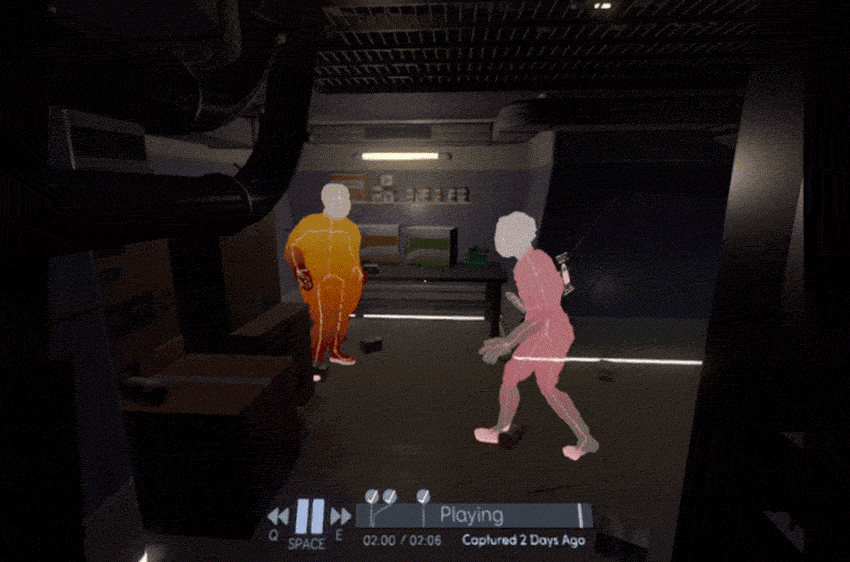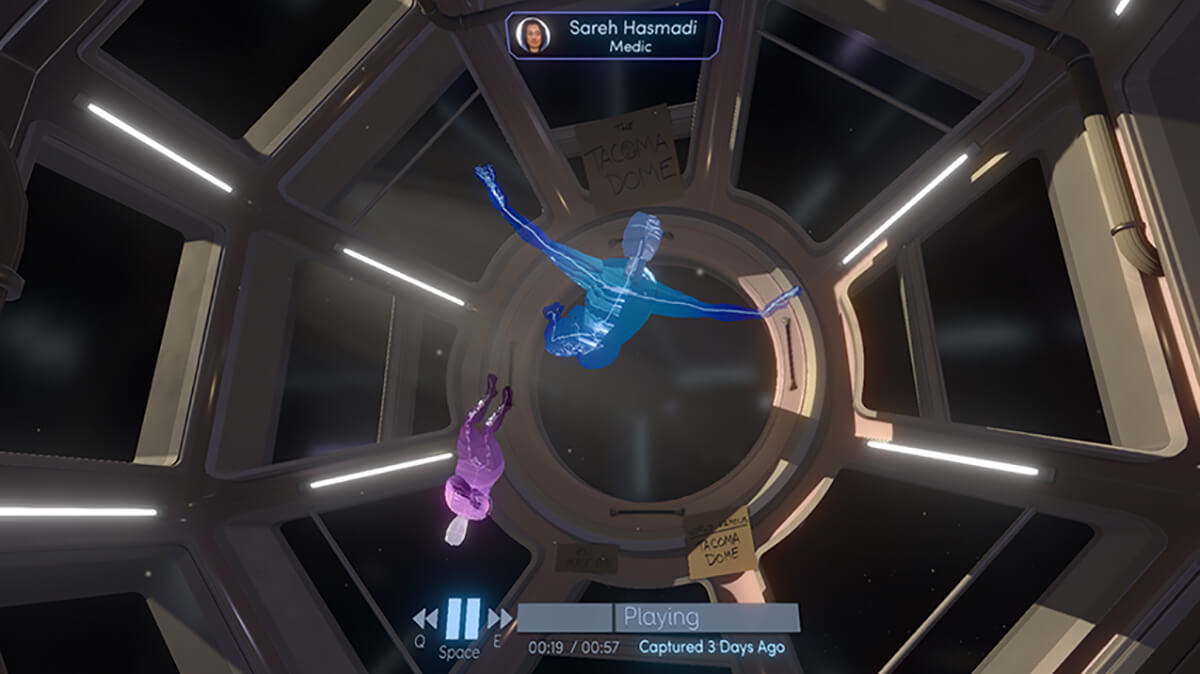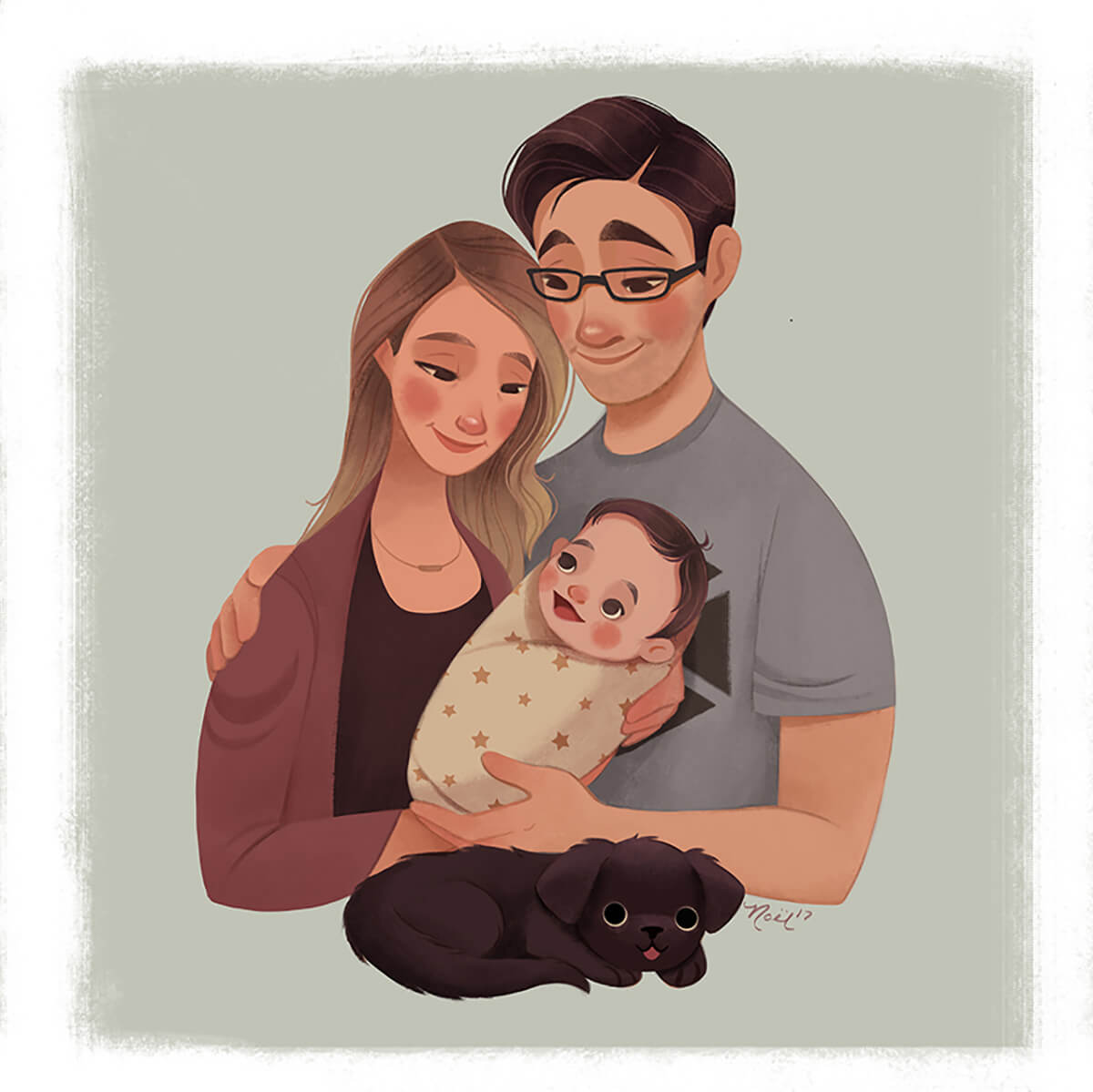In the Fullbright Company’s new game Tacoma, none of the characters have faces. There’s a good reason for that – they’re all holograms. It’s one of the game’s most noticeable design features, and it had a huge impact on the work of lead animator Noël Clark, a DigiPen graduate from the class of 2012 who faced the challenge of bringing those translucent characters to life.
“I’m glad they didn’t have faces,” Clark says. “Facial animation is so time consuming and difficult to make not … creepy. It was fun to animate their full bodies and try to push the poses and make everything read with just their bodies.”
The follow-up to Gone Home, the Portland indie studio’s pioneering entry into the burgeoning “walking simulator” genre, Tacoma takes place aboard the eponymous space station in the year 2088. Assigned by Venturis, the megacorporation that owns the station and many others orbiting Earth, you play as contractor Amy Ferrier from the California Republic, ordered to retrieve the abandoned ship’s onboard AI, ODIN.
What happened to the ship’s eight-person crew is initially unclear, but you get to know them intimately during your time exploring Tacoma. That’s because the station’s augmented reality interface was programmed to record the crew’s actions and conversations during the dramatic events leading up to Amy’s arrival, and you can view these AR recordings in real time, as well as fast-forward and rewind them at your convenience. As these bygone moments play out in different parts of the ship, reenacted by monochromatic AR representations of the crew’s human forms, the mystery slowly reveals itself.
Despite the crew’s indistinct, ghost-like figures, the characters in Tacoma exude mountains of emotional depth, thanks largely to the game’s excellent voice acting but also to the work of Clark. On the visual end, it’s Clark’s animations that do most of the emotional lifting – communicating personality through motion alone.
“For instance, Sareh, the medic, is kind of reserved, so in a lot of her gestures she’d bring her hands together and be closed in,” Clark says. “She wouldn’t gesture as big as say, E.V. [the station administrator], whose movements would be a lot bigger. Or take Nat, the IT girl. She’s a little more erratic, so there are some scenes where she moves really quickly in small spurts.”

During her time as a student in the BFA in Digital Art and Animation program, Clark’s initial interest in 2D animation turned into a passion for 3D. The shift surprised her, given how much she disliked the medium at first, even at a physical level.
“If I worked too long, I would literally get motion sick from doing the homework,” she laughs. “But now I really like it. As soon as I learned the tools better and realized they are just tools and that all the 2D fundamentals apply … if you think of it that way, working in 3D is better.”
Along with her dive into 3D animation, she also found herself learning more than she anticipated about several other industry roles, from modeling to rigging to working directly with game engines, and developing broader skillsets because of it. While still at DigiPen, Clark took an internship at Microsoft Game Studios, which eventually led to a full-time job upon graduation. There, Clark worked as an animator on Xbox One titles like Fable Legends, Ryse: Son of Rome, and Forza Motorsport 5. At Microsoft, Clark says, she realized how valuable her omnivorous education at DigiPen had been.
“For me it was actually really beneficial that I wasn’t super focused in one area,” Clark says. “People talk about, ‘What’s better — being able to do one thing really well, or a lot of things pretty well?’ For me it kind of worked in my favor having knowledge of a lot of different things from my time at DigiPen, because when I worked on different teams at Microsoft, I knew what the modelers and riggers were doing even if I was just doing animation.”
While Clark’s polymath approach initially helped her during her internship, once she started full-time at Microsoft, she found herself considerably more siloed. “I worked on bigger teams where I only animated,” Clark says. At first she enjoyed getting to focus solely on her one job: animation. “But the challenge I had with that is I didn’t have a great understanding of what else was going on with the project. I’ve worked on some projects where I never even opened the game engine, because I was just handing off my animations.”
People talk about, ‘What’s better — being able to do one thing really well, or a lot of things pretty well?’ For me it kind of worked in my favor having knowledge of a lot of different things from my time at DigiPen.”
Once she left for Fullbright, things changed quite a bit.
“Before Tacoma,” Clark says, “I don’t think I’d ever worked on a game where I knew all the details about it as I was working on it, which is … kind of important.”
At Fullbright, the team checked in on the story points together, making sure everyone understood Tacoma’s interwoven narrative threads about labor unions, corporate control, and the ethics of AI.
“By the time I started animating,” Clark says, “I had a pretty good idea of who these characters were. We’d had a lot of discussions in the office about who they were and how they do things.” The team even got a chance to embody the characters themselves, doing scratch voiceover takes together (where Clark got to voice a mechanic named Bert) and recording their interactions as video reference material for the different crew members (where Clark got to act every character at least once).

Working on a smaller team, she was able to have more control over how her animations were implemented, and the broad knowledge base Clark built up at DigiPen came back to the forefront as well.

“I kind of became the shader person,” Clark says. “I was making custom shaders for the characters and some other things in the game. I never thought I would have been the one to do that because it’s fairly technical.” But thanks to her wide skillset and a handy visual node-based shader program in Unity, Clark was able to take the reins for the team without knowing any shader code. “It’s always fun learning new things,” Clark says, “and that was very new.”
Now that Tacoma is out, the Fullbright team is working out a few patches and banking up ideas for their next title. Clark, in the meantime, is returning to some of her 2D illustration work, the kind of work that got her into 3D video game animation in the first place. And the launch of Tacoma isn’t the only exciting development that’s happened this year. “I just had a baby too,” Clark says, “so our little Charlie is keeping our family busy.”
